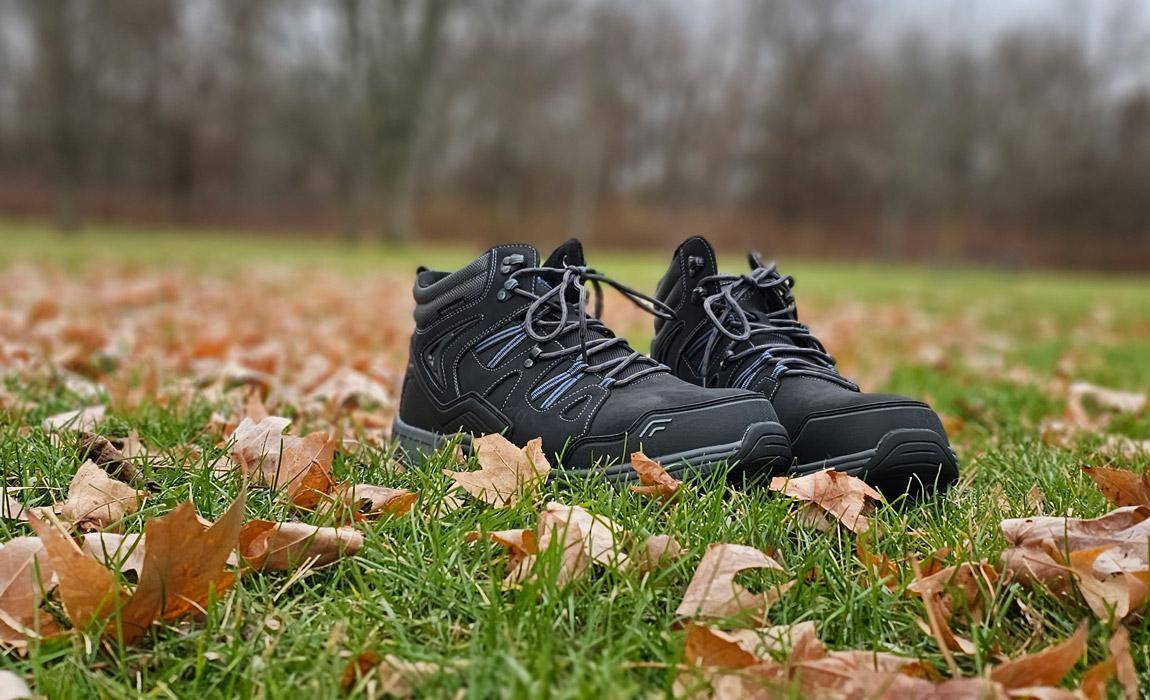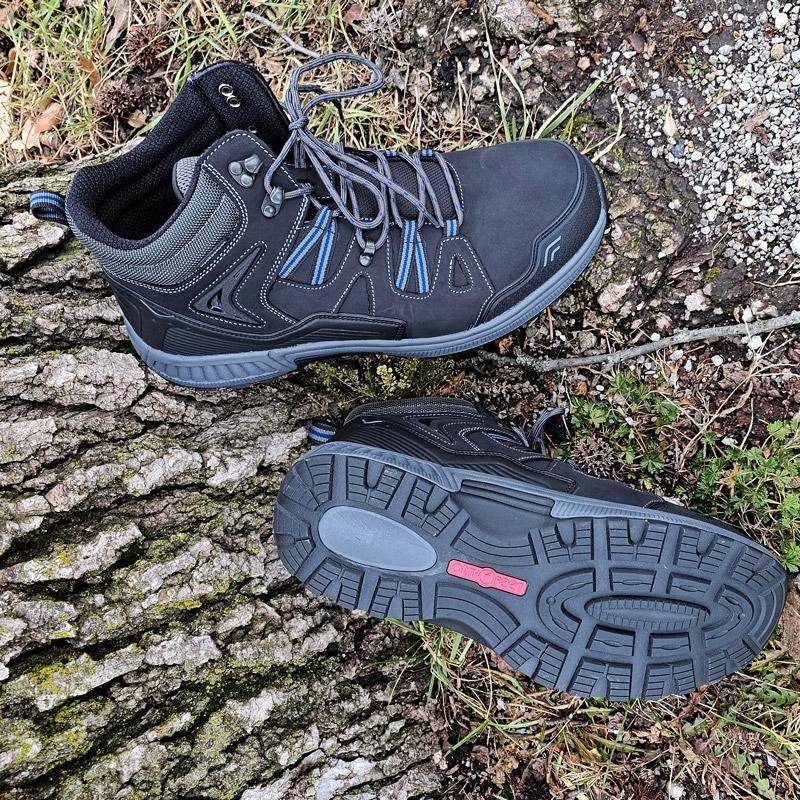There’s no shortage of different styles of winter boot to pick from and so it is important to take a moment and think about what your needs are during these cold, dark, and frankly - dangerous months where poor choice in footwear could result in an expensive medical bill. Cross trainers and walking shoes are easy to shop for by comparison since they tend to be less expensive and have fewer responsibilities in terms of protecting your feet.
Thankfully though, for me (and you!), OrthoFeet makes some great winter boots that are a fantastic option for guys with medical conditions such as Arthritis, Knee Pain, Neuropathy, and Swollen Feet that come complete with spacers that allow you to customize the fit for each foot.
For me, this is a game changer since I typically end up ordering a pair of shoes a size larger to accommodate my left foot that is now slightly larger than my right. Not only does this leave my right foot loose in the shoe - but it leads to an uneven gait, hip and knee pain when walking or hiking, and ultimately a less than stable posture that in winter months can lead to slipping and falling easier than if my shoes fit properly.
When I wear OrthoFeet shoes and boots though, that’s not something I have to worry about.
To test these boots out I took a walk through one of the local parks here in Toledo, Ohio and I was frankly surprised at how comfortable they were - just simply for walking and kicking some leaves around and I might have jumped in a puddle or two too 🙂
They say that snow is in the forecast again later this week so even though I couldn’t test these treads on ice yet - Mother Nature is certainly going to give me the chance way sooner than I’d like!
What Conditions Are You Looking To Face This Winter?
When deciding on winter boots, it's important to take into account the type of weather conditions one might encounter during these cold and dark months. We’ve previously written about this topic more from a fashion perspective and I suspect that was influenced by the fact that both myself and the writer who helped with that post both lived in Southern California at the time.
From our perspective at that time, our exploration of winter boots was more about fashion and protecting from rain - not avoiding slipping on ice and keeping your feet dry while shoveling snow, walking through slushy sidewalks on the way to work, or through the snow to watch some pond hockey.
No matter where you go, your priorities will differ slightly - but the conversation remains an important one to have so that you pick the perfect pair of men’s winter boots.
Here are some factors that are important to consider when shopping for a pair of winter boots.
| Factor | Why It's Important |
| Insulation | Adequate insulation ensures feet stay warm in cold temperatures, essential for comfort and preventing frostbite. Different materials like Thinsulate or wool provide varying degrees of warmth. |
| Waterproofing | Waterproof materials like Gore-Tex keep feet dry in snow and slush. Wet feet can lead to discomfort, blisters, and a risk of frostbite. |
| Traction | Outsoles with good grip, such as those made from rubber with deep lugs, reduce the risk of slipping on ice and snow. |
| Durability | High-quality materials and construction ensure the boots last through multiple winters, making them a better long-term investment. |
| Fit and Comfort | Proper fit prevents blisters and discomfort. Features like cushioned insoles and supportive design enhance comfort for prolonged use. |
| Breathability | Boots that allow moisture to escape prevent overheating and sweat buildup, maintaining comfort and hygiene. |
| Weight | Lighter boots reduce fatigue during extended wear, but shouldn't sacrifice insulation or durability. |
| Style | The design should suit personal taste and be appropriate for intended use (casual, formal, outdoor activities). |
| Ease of Use | Features like quick-lace systems or zippered closures make boots easier to put on and take off. |
| Price | Price should align with budget and intended use. More expensive doesn't always mean better, but investing in quality can be cost-effective in the long run. |
As with everything in life, the right choice for your needs will be based on a sliding scale of priorities and so what’s right for my needs isn’t always right for you - though honestly we’re pretty smitten with these from OrthoFeet since they provide excellent all-around support for the winter months but weren’t too heavy to make them uncomfortable for hiking in the spring when mud is more of a factor than snow.
A Steady Foot Starts With A Sturdy Sole and Strong Ankle Support
This piece emphasizes the significance of robust soles and robust ankle support, integral elements that guarantee stability and safety in winter boots. These elements aid in maintaining balance, preventing mishaps, and ensuring comfort during your winter exploits.
Sturdy soles rely heavily on their materials. Key characteristics to consider include:
- Sole materials: Rubber ranks high due to its resilience and water-resistance. It can endure severe winter conditions while offering a good grip.
- Tread patterns: Deep, broad treads provide enhanced traction on snow and ice. Seek out intricate patterns to bolster stability. This includes deep lugs to grip into loose terrain, slush, ice, and mud - just like a good off-road tire.
- Ankle stability: High-top boots provide unmatched ankle support. This lessens the likelihood of sprains and other mishaps.
- Lace up techniques: Laces should be robust and simple to adjust, even with gloves on. This allows a secure fit and ensures the boot stays on firmly.
The right boot height and lace-up techniques also play a part in ankle stability. It's not just about selecting fashionable boots - it's about securing the pair that ensures your safety and comfort. Your winter exploits rely on the comfort and safety of your feet. Choose wisely.
Weather Resistant Or Waterproof Boots - What's The Difference?
Understanding the difference between weather-resistant and waterproof boots is a significant aspect when considering winter footwear, as it can greatly affect your winter experiences.
Weather-resistant boots are designed to endure severe weather conditions but are not completely water-resistant. They are durable and have long-lasting material that resists snow and light rain. However, they are not the best option for heavy rain or big puddles. On the bright side, they offer superior breathability, which is an important consideration for active individuals to avoid overheating and discomfort.
Waterproof boots on the other hand, offer excellent protection against water due to specialized types of insulation that keep feet dry, even in heavy rain or deep snow. In the case of OrthoFeet’s Ridewood Black winter boots, the design features a waterproof upper as well as membrane that will allow moisture from sweat to escape.
However, these boots might need more care to keep their water-repelling properties since the material will need to be maintained properly so that you can avoid damaging the surface of the fabric i.e. handwash and dry vs putting in the washing machine like you might have done with other boots in the past.
When deciding between what type of water protection that you need, think about your winter activities. Weather-resistant boots could be the top choice if you plan to take short hikes in snowy but milder conditions. For wetter, more severe environments such as long walks on dirt walking paths or standing outside watching pond hockey, or going ice fishing - waterproof boots will serve you better. The goal is to find a pair that offers the right mix of protection, comfort, and durability for your winter activities.
Bigger Heavier Work Boots Aren't Always Better For Walking On Snow And Ice
During the chilly season, many harbor the misconception that larger, weightier work boots are the optimal pick for navigating through snow and ice. However, if you're someone who stays physically active, you'll quickly discern this isn't consistently accurate. I've discovered from my own encounters that other elements are quite important and often neglected.
- Significance of Insulation: A boot with good insulation is vital. Your boots' size or weight becomes irrelevant if your feet are freezing. Opt for boots that provide a balance between insulation and ventilation.
- Durability of Material: Larger boots might imply more material, yet it doesn't guarantee superior quality. Materials that are durable resist wear and tear, giving your boots a longer lifespan.
- Maintenance of Boots: The larger the boots, the more upkeep they demand. Compact, well-looked-after boots can outperform neglected larger ones.
- Evaluating Traction: This is extremely important when dealing with icy conditions. A boot that is lighter but has exceptional traction is safer than a heavier one with subpar grip.
Finally - weight is a critical factor here. While some men will need a good pair of waterproof work boots with a steel toe to protect them on the construction site or thicker material to protect their feet when running a snow-plow, staying nimble and maintaining a stable gait is essential in terms of protecting from falls and maintaining a maximum level of knee, hip, and foot comfort.
This all comes back to the objective to find a pair of winter boots that fit you perfectly so that you can maintain better comfort and efficiency when walking on snow and ice. Don't let bulky boots that look tough and rugged be the deciding factor here.
Orthofeet Winter Boots For Men - A Perfect Fit For Any Foot
The Orthofeet's Ridgewood winter boots have been a game-changer for active men like myself, offering unbeatable comfort and an ideal fit. With features that include a waterproof membrane and high-quality, water-sealed leather, these boots can withstand anything that a Michigan and Ohio winter can throw at me this year. The wide toe-box is beneficial for conditions like bunions and hammertoes, and the soft, padded fabric inside guarantees a wear free of irritation.
These boots are designed to accommodate a variety of foot conditions, including flat feet and plantar fasciitis, and are ideal for individuals with diabetes, arthritis, or neuropathy. The cushioned sole, paired with a mild rocker design, greatly eases walking.
Product Features:
- Waterproof membrane
- Water-sealed leather
- Wide toe-box
Benefits:
- Suitable for various foot conditions
- Excellent comfort and fit - Men’s size 7-14 and D-4E width
- Durable and weather-resistant
- Each pair comes with premium orthotic Insoles and adjustable arch supports
In addition to the Ridewood Black model that I tested out, they also offer the Ridgewood - Brown and Hunter - Black as a waterproof winter boot option. For those where water repellent is an option, they have a new model - Hunter Olive that is water repellent.
For those guys looking for a rugged work boot that still offers all of the quality and orthotic benefits that Orthofeet packs into every one of their shoes - the Granite Work Boots are a great option for year-round comfort and protection.
Conclusion
Selecting the ideal pair of winter boots requires understanding your specific needs.
Take into account the weather conditions you're likely to encounter and remember that larger isn't always better.
Aim for a balance between durable soles and robust ankle support, and comprehend the distinctions between weather-resistant and waterproof. Orthofeet winter boots for men provide a versatile option for any foot type. Keep in mind, staying active doesn't imply you have to give up comfort.
Gear up smartly and take pleasure in the winter months. I know I will be keeping warm and staying active while wearing these Ridgewood black OrthoFeet winter boots.






